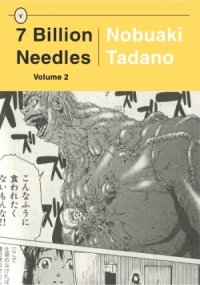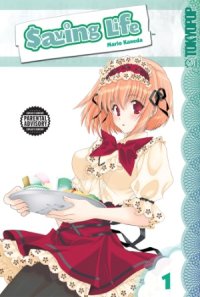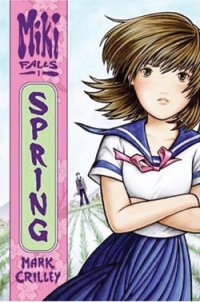RIGHT TURN ONLY!!
Exactly According to Genkaku
by Carlo Santos,

Pacific Media Expo 2010, or HallwayCon, will go down in Southern California convention history as a notoriously bad choice of location—the Pasadena Hilton, which has about zero open spaces. Many indelible memories were formed here, mostly of trying to squeeze past other attendees and trying not to walk in front of cosplay photoshoots. But there was, at least, one shining moment when the Redeeming Power of K-pop stole the show:
7 BILLION NEEDLES

Vol. 2
(by Nobuaki Tadano, Vertical, $10.99)
FROM THE BACK COVER:
"Deepening the homage to Hal Clement's sci-fi classic Needle with an island setting, this second of four volumes will melt your mind as well as your heart. Perennial headphones keeping out the world, Hikaru once seemed content not to be like her superficial classmates at all. But when a voice tells her through the headset that it's from outer space on a mission and needs her cooperation, the oddness is more than she really cares for."
EVIDENCE FOR:
If God is in the details, then 7 Billion Needles must be divinely inspired, the way it brings together all these different plot points and genre elements to form a satisfying whole. Hikaru's newly made friends from Volume 1 join her for a summer excursion that somehow manages to be a family drama, coming-of-age epiphany and intergalactic beatdown all at once—and never misses a beat between storylines. The memories of Hikaru's father (and how she lost him), the reasons why she closed herself off from the world, the places and people on the island she once called home: Tadano's storytelling is almost in weepy slice-of-life mode here, but at the same time it sets the stage for the next space-age showdown between Horizon and Maelstrom. And that, of course, is when this story arc really takes off, with fantasy, reality and memory crossing wires in Hikaru's head (always a fun narrative concept) and the artwork exploding in rich detail, ranging from idyllic greenery and rustic views to alien monstrosities straight out of the best horror works. Although intricately drawn, the images follow each other in smooth sequence, resulting in a bold, fast-paced adventure that easily feels like a story twice its length.
EVIDENCE AGAINST:
Okay, I gave this series some grief before for being a Parasyte wannabe, but that didn't mean I wanted it to drop the high-concept sci-fi philosophy part! As the story focuses on the more worldly details of the characters and plot, Hikaru's conversations with Horizon about the meaning of humanity and our place in the universe are the first thing to go, reducing the intellectual appeal. And to be honest, that story shift from head to heart may not be the best use of Tadano's talents: his dry, matter-of-fact storytelling and clinical art style (with lots of photo-reference) often creates a detachment between the reader and the characters' feelings. Those scenes with Hikaru, her father, and her childhood memories ought to be big-time tear-jerker moments, but instead they're just there, going by with nary a flutter of one's heart. And the other part that ought to get folks all pumped up and emotionally charged—Horizon vs. Maelstrom Round 2—feels a little fake as well. It's just hard to feel invested in the battle with all the flashy special effects and the aliens represented as nebulous entities of light. How do you root for characters like that?
FINAL VERDICT:
It may have a bit of that "hard sci-fi" coldness, but the multi-faceted story and sharp artistry leave a strong enough impact to earn this volume a B.
GENKAKU PICASSO

Vol. 1
(by Usamaru Furuya, Viz Media, $9.99)
FROM THE BACK COVER:
"Having cheated death, Hikari Hamura must save himself by using his artistic abilities to help others.
Hikari Hamura, nicknamed Picasso because of his natural artistic abilities, survived a horrible accident, but his friend Chiaki wasn't so lucky. Suddenly, Chiaki appears in front of him and tells him in order to keep living he must help the people around him. Can Hikari save people with his sketchbook and a 2B pencil?"
EVIDENCE FOR:
Using different art styles to depict different realities may be a familiar old gimmick, but when someone of Usamaru Furuya's talent level does it, the results are instantly fresh. As the protagonist is transported into outlandish drawings of his own creation, Furuya creates surreal sketch-worlds that aren't just nibbles of eye candy—they're more like a full-on eye smorgasbord. Between giant babies, S&M bondage scenes, wasteland amusement parks, and gothic Visual Kei imagery, it's as if Salvador Dali had been born a manga-ka and decided he was on a quest to weird you out. And it's not just shallow artistic indulgence, either: the stories themselves reveal universal truths about the relationships between others, whether it's the bonds between father and son, or two sisters trying to carve out identities for themselves, and how Hamura's strange ability (besides being just cool to look at) can help all of them in unexpected ways. Throw on top of that a twisted sense of humor—Hamura plays the sarcastic, socially awkward savant perfectly—and the deep, memorable characters that he finds himself hanging out with, and it's clear that Genkaku Picasso succeeds on every level.
EVIDENCE AGAINST:
Maybe great minds like Furuya's shouldn't be subjected to the restraints of regular serialization. Despite Picasso's originality and depth, each chapter ultimately boils down to a standard monster-of-the-week (or rather, month) format, with our hero being forced to fix his peers' problems by magically jumping into his wacky drawings. No twists, no epic story-building, just the same general mystery-solving structure every chapter like Case Closed. And the mysteries aren't necessarily that clever, either: Furuya tosses a clunker in Chapter 2 with the baby and the rabbit (very obvious and awkward symbolism once you know the story) and an essential plot point that beggars belief. The third and fourth chapters, meanwhile, feature strong story execution but rely on themes that are already pretty overdone for the genre—like summoning the courage to talk to one's crush, or being true to one's self while idolizing a music artist. Perhaps the price of revealing universal truths is that they all sound hokey after a while.
FINAL VERDICT:
Story contrivances can be overlooked when you've got the Japanese Salvador Dali spilling the contents of his brilliant mind. Couldn't ask for much more in this A- effort.
I AM HERE!

Vol. 1
(by Ema Toyama, Del Rey, $16.99)
FROM THE BACK COVER:
"Invisible to her classmates, Hikage Sumino is an eighth grader with no self-esteem. Her only friends are the visitors to her Internet blog. One day, the most popular boy in the grade suddenly talks to her. Encouraged by this twist of fate, Hikage determines to transform her life."
EVIDENCE FOR:
Uplifting. Empowering. Ennobling. These are not words you would normally use to describe the average middle-school romance manga—unless it's I Am Here!, which tells a moving tale of one girl's struggle to overcome crippling shyness and peer pressure. Although her relationship with school hottie Hinata is what gets the story moving, its real heart and soul can be found in the moments that focus on Sumino alone. Her stirring speech in Chapter 7—where she stands up to an entire classroom of bullies and would-be accusers—is easily the book's high point, a triumph that will have readers jumping out of their seats to cheer her on. Other moments are not quite as dramatic, but still heartwarming: Hinata braving the rain to help protect Sumino's personal garden, the two of them sharing a moment overlooking the town, and the unflagging support that Sumino gets from her online friends. There are dark moments too, with the torment that Sumino must face when rival girls challenge her for Hinata's attention—but it is the way she fights back, the way she goes against her own nature to stand up for what's right, that creates a shining beacon of beautiful, emotionally true storytelling.
EVIDENCE AGAINST:
This story would indeed be a deep and moving masterpiece—if Ema Toyama could draw decently. Instead, we get a series that rides almost entirely on the merits of its heartstring-pulling story, because the bog-standard artwork probably isn't going to attract many eyeballs. As a heroine, Sumino is painfully ordinary-looking, to the point where in some scenes she gets lost in the crowd (she's supposed to be "plain," but there should at least be a visual cue to help people spot her). Her love interest interest isn't much better, being the dark-haired half of a typical ikemen duo and having no distinguishing features from all the other school-age male romantic leads in manga. And if it's not bad character design, it's bad background work, with endless screentones and sparkles being used as a cover-up for artistic laziness. The over-the-top character types can be off-putting as well: Sumino's shyness, Hinata's kindness, and rival Aya's pettiness are all exaggerated to the point that it makes them hard to believe. And for those who figured out the twist behind the commenters on Sumino's blog ... yeah, they telegraphed that one way too easily, don't you think?
FINAL VERDICT:
It may not be perfectly crafted, but the sheer emotional pull and the story's contemporary focus on issues like bullying and online friendships lift this one to a B.
SATURN APARTMENTS

Vol. 2
(by Hisae Iwaoka, Viz Media, $12.99)
FROM THE BACK COVER:
"Earth has been abandoned as a nature preserve and the human race now occupies the Ring System, a gigantic structure that surrounds the planet. Mitsu has just started working as a window washer, a dangerous job that five years earlier led to the loss of his father. As Mitsu struggles with being the new guy—making mistakes, struggling to keep up, handling petty workplace resentments—he also discovers the simple pleasures of befriending his coworkers, enjoying time off and getting to know his absent father through the eyes of his colleages. All of this is part of growing up in the cramped urban quarters of the Saturn Apartments."
EVIDENCE FOR:
For a series about living in space, Saturn Apartments continues to be remarkably warm and down-to-earth, highlighting the human bonds that connect us universally. The middle chapters of Volume 2 are a welcome interlude from the standard "Mitsu washes windows; learns life-affirming lesson" formula: he goes on a refreshing day trip, hangs out with co-workers at a bar, and attends a summer festival, all of which help him understand more about his father by conversing with friends. So even though Mitsu's life seems to be a chain of random assorted episodes, it's actually adding up to his growth and self-understanding as a young man. Of course, his window-washing exploits have their moments too—whether it's the gentle humor of "The Glitter," where a bald guy's head turns out to be miraculously luminous, or the poignant drama of helping others in need. (An elderly woman requires medical attention in the first two chapters; an old man reunites with family in the last one.) The delicate lines and shading give warmth to an environment of pressurized chambers and reduced gravity, not to mention the striking character designs and backgrounds. Among various accounts of the future, this one is a world unto itself.
EVIDENCE AGAINST:
You know where else I can learn about the value of working hard, forming friendships, and understanding one's parents? MY ACTUAL LIFE. Saturn Apartments, in its attempt to capture the rhythms of the everyday working class, does too good a job of it and turns out to be this monumental bore that ought to be called "Some Guy Goes Out And Does Stuff." Because that's all the series is ever about. Even worse is when he does stuff that's not work-related and we get the nebulous, directionless middle chapters where he's chatting idly with friends about topics like "How's work going for you?" and "Do you remember much about dad?"—come on, this is the stuff I talk about with my co-workers when there's nothing else interesting to say. It may all be coated with a layer of feel-good sentiments, but even that is starting to grow tiresome, to the point where the ending of the "Mitsu helps an old man" chapter can be guessed from 5 pages away. Simply put, Saturn Apartments has the look and feel of a cheap greeting card, and about the same depth and content.
FINAL VERDICT:
True, the stories are about as exciting as actually going to work for an 8-hour shift. But for those who seek pleasant, calming truths about life, it's still well-crafted enough for a B-.
SAVING LIFE

Vol. 1
(by Mario Kaneda, Tokyopop, $12.99)
FROM THE BACK COVER:
"Haruhiko was born rich and grew up pampered. But when he can't take any more of his father's tyrannical behavior, he strikes out on his own, determined to make his own way in the world. But going from super-rich to super-poor is tough on any man (let alone one still in high school!), and it's going to take more hard work than Haruhiko imagined just to make ends meet. He's doing his best and trying to keep up his spirits, but living on bean sprouts and bread crusts is enough to get any man down. Fortunately, he's got his sexy classmates and his own personal (and very hot) maid to help him out!"
EVIDENCE FOR:
In a world filled with supernatural gimmicks, fetish-driven moefests, and grand universe-spanning storylines, there is something strangely refreshing about a traditional harem comedy where the guy is just trying to live his life while a bunch of cute girls keep ruining it. They just don't make series like that anymore—and Saving Life keeps things blissfully simple that way, relying on a downtrodden everyman and his offbeat comedic mishaps to create a lightly amusing romp. Haruhiko is—dare we say it?—actually likable as a guy surrounded by way too many girls, with his hardworking attitude and frugal ways that you can't help but admire. At the same time, though, there's that bit of a crazy streak that makes the series fun: Haruhiko's bizarre idea for making beat-up old TVs usable, an elaborate wordplay gag involving bread rolls, an attempt to win a raffle that goes awry, and other bursts of the unexpected. Plus with the simple, to-the-point artwork and layouts, this is a quick, painless read that will make you chuckle without making your head spin.
EVIDENCE AGAINST:
Oh, there is plenty of pain to be had here ... considering that this atrocity revisits all the old harem comedy clichés that have long since gone out of style. Want to know why it feels "strangely refreshing"? Because good manga licensors learned to stop releasing junk like this years ago! Instead we are subjected to slapstick tomfoolery of the lowest order, and even a few clever, off-beat gags can't balance out mindless scenarios like "Sell the most items at lunchtime" and "Earn enough money to repay a crushing debt." The worst part, though, is the poorly-timed fanservice, which always shows up in gratingly obvious ways—moments where you just know Haruhiko is going to get a faceful of panties because he performed a highly unrealistic pratfall moments earlier. It's as if Mario Kaneda storyboarded the fanservice shots first and wrote the rest of each chapter around those, and that is no way to build a convincing comedy. Not that the fanservice is even that enjoyable in the first place: the plain, unappealing character designs and poor sense of anatomy all but guarantee that those delicious thighs and ample chests will be forgotten as soon as the page is turned.
FINAL VERDICT:
Even those who like their mindless ecchi harems would do well to look elsewhere before digging this one from the bottom of the pile where it ranks a D.

DANIEL X

Vol. 1
(by James Patterson with Michael Ledwidge and SeungHui Kye, Yen Press, $11.99)
FROM THE BACK COVER:
"When his parents are murdered by an intergalactic criminal, Daniel X vows to take on his father's role as Earth's sole Alien Hunter. Life isn't easy, though, when you're a young boy on your own, tracking down the galaxy's deadliest outlaws. Luckily, Daniel has a gift: the ability to create anything he can imagine—including his parents, his sister, and his best friends, who are there to help him along the way. But when Daniel decides to go up against the sixth-deadliest criminal on his hit list, he may find that even his awesome abilities just aren't up to the task!"
EVIDENCE FOR:
Don't you just hate how getting into some sci-fi franchises requires catching up on dozens of novels and comics and TV episodes and movies? Well, here's one that manages to fit a self-contained interplantary epic into a single volume. The first adventure in the Daniel X series starts out as a typical X-Files-like thriller, where alien forces secretly mingle with humanity and occasionally get into action-packed scrapes—but the real fun starts halfway through, when the story dramatically expands and becomes a saga across the stars. When Daniel's origins are fully revealed, along with a rich back-story about who he is and the people around him, the depths of James Patterson's imagination becomes clear. Of course, it also doesn't hurt that the finale soars with drama and thrills and some good old action-hero ingenuity. SeungHui Kye's art is also up to the task of rendering this fantastical journey, with distinctive characters on the human side (Daniel's pals are attractive and easy to tell apart) as well as some seriously nasty aliens. Imagination also comes alive with the stunning spacecraft and landscapes in Daniel's alien world, and the well-spaced layouts promise an exciting, fast-paced read from start to finish.
EVIDENCE AGAINST:
Really? This is what James Patterson is lauded for, coming up with sci-fi epics that are basically patchwork reconstructions of other sci-fi epics (not to mention fantasy and action-adventure)? Then again, I probably should have bailed right after "Daniel's parents die when he's a baby," because everything else after that really is just one hero-of-destiny cliché after another. Of course he's on the run from authorities, of course the enemy was lying in wait for him in a shocking twist, and of course he gets to discover his incredible, heartbreaking back-story, because without it he doesn't get the motivation to fight the final villain in a perfectly contrived battle. Come on, they churn out plotlines like this at community college workshops—not to mention hundreds of NaNoWriMo projects. And because of the density and pacing of comics versus prose, the entire story feels too light and unsatisfying, like we're just getting an abridged Daniel X without getting a real feel for the characters and the world they live in. Not that their world is all that great—Kye's art shows clear weaknesses and shortcuts in some of the glossy, fake-looking backgrounds and props (especially in city and school scenes).
FINAL VERDICT:
Yes, it's basically a predictable sci-fi potboiler that steals from better works—but as far as action-packed entertainment, it's still polished enough to be enjoyable.

Once again, dear readers, I must unfortunately get on my hands and knees and point out that I got no Reader's Choice submissions in the last two weeks. This always makes me cry a little inside because I hate to think that my column is so unpopular that nobody wants to participate in it! I know of at least one guy who went on to become a columnist for another website because they liked the reviews that he sent in here—so just think, internet fame and fortune can also be YOURS!
Meanwhile, from the archives, here's an extra dose of worldly global international manga review-age, courtesy of Gina Ventola:
MIKI FALLS

(by Mark Crilley, Harper Collins, $8.99 ea.)
Summary: The Original English Language manga Miki Falls, by Mark Crilley, is about a Japanese high school girl, Miki, who falls for a mysterious young man, Hiro. She finds out his secret—he's a semi-celestial being known as a Deliverer, who arranges for people to fall into and out of love. The only problem is, he's denied love himself. Yet Miki and Hiro are determined to keep the flame of romance alive between them, against all odds, even if it kills them. But how can they win when fate seems so against them?
Pros: The manga was quite easy to understand, due to its use of narrative boxes, which showed in text Miki's point of view. That made the story flow swiftly, too. The characters were easily distinguished from each other, unlike manga such as Kare Kano where I had a hard time telling the supporting characters apart. The artwork was pretty and very shaded—there's no people with skin tones matching the page color here. The story starts out with a bang and doesn't let up from there. Mark Crilley may be a Westerner, but having lived in Japan, he creates a believable Japanese setting. It seems authentic, but I've never been to Japan myself, so how would I know? But given all the research I've done on Japan, it seems good to me. He keeps you guessing until the end whether Miki will let fate win.
Cons: Narrative boxes? I know some people think that dumbs a story down. "Show, don't tell," so they say. But it's not really a con with me. I need someone explaining what's going on—many modern day graphic novels and comic books confuse me for lack of narrative boxes detailing what it is we're seeing in the picture. For instance, one of the reasons I gave up on Trigun Maximum is I couldn't figure out what was going on in the panels. And another reason why I liked the narrative of Miki Falls was telling a story from the first point of view almost always makes a story more grabbing. Okay, this wasn't really a con box. There were no major cons.
I'm giving the four volumes of Miki Falls an A, because it was an enjoyable, fast-paced, easy to understand read. It's also a great story for hopeless romantics.
Is there a hidden gem of manga you'd like to reveal to the world? Is there a piece of garbage that deserves to be bashed in public? Or is there a title that didn't get a fair grade here, and you want to set the record straight?
Now's YOUR chance to be the reviewer! Write a review of about 300-400 words (a little more or less is fine) and include:
- Your name
- Title of manga (and volume no., if applicable)
- Author/Artist
- Publisher
- Briefly describe the story, then explain why this manga is great, terrible, or in between. Be objective, but also be entertaining.
Then send it in to rtoreaders (at) gmail (dot) com (plain text format preferred). One review will be selected out of all the submissions and will be published in the next column. All types of manga and manga-inspired comickry are accepted, from past and present, from Japan and beyond—what matters is that it's the Reader's Choice! NOTE: Submissions may be edited for formatting and grammar.
discuss this in the forum (14 posts) |